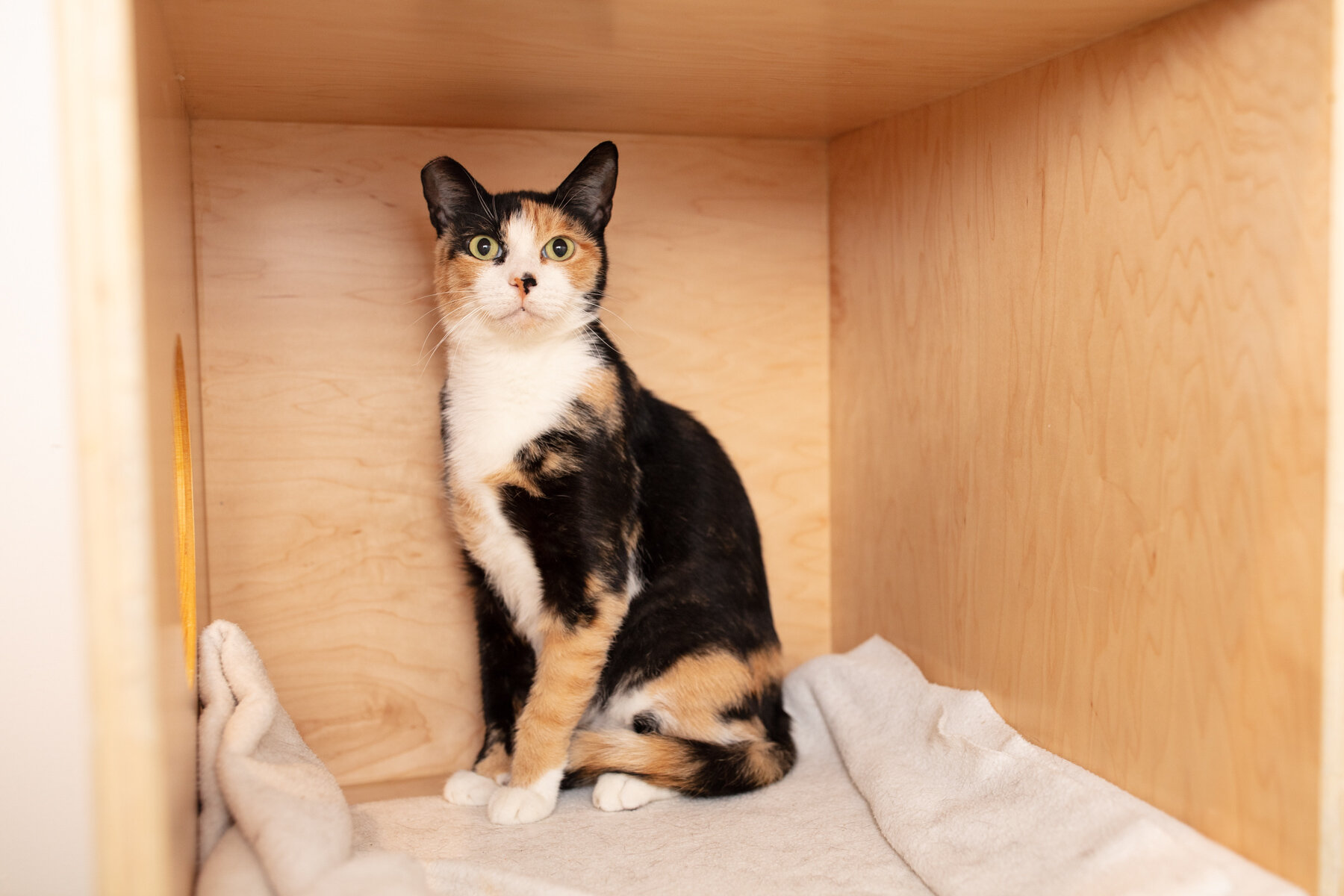Calico Cat Facts to Know
No matter their fur pattern or coloring, all cats are special in their own unique way. Some, like calico cats, may just be a little more eye-catching though, and you might wonder why that is. Whether you’re looking to adopt a calico cat and want to learn more about them, or if you just need some fun facts to impress your friends with at trivia night, let’s dive in and learn about calico cats!
Calico cats have a distinctive coat pattern.
A calico cat isn’t a specific type of breed — in fact, they can be any domestic cat breed with a tri-color coat; typically black, orange, and white. The white can be 25-75% of their fur. However, variations including cream, blue-black, brown, and reddish-orange can also be found in calico cat coats.
Tortoiseshell cats (or “torties”) are often mistaken for calico cats, and vice versa, since torties have black and orange in their coats. The main difference between the two is that tortoiseshell cats have a black-based coat while calicos have a white-based one. And just to confuse you even further, outside of the U.S., many people call calicos “tortoiseshell and white cats!”
Calico cats may have originated from Egypt.
Calico cats have been around for a long time. While there’s no way to be 100% certain where they originated from, one study traced calico cats along shipping trade routes in Europe and Northern Africa. The orange mutant gene that’s found in calicos likely originated from Egypt and was traced to port cities along the Mediterranean Sea in France, Greece, Italy, and Spain. It’s believed that Egyptian merchants took calico cats aboard their ships to help keep their vessels from being overrun with mice and rats. As the ships sailed from port to port, the cats started to travel throughout the world and spread their unique fur and coat pattern genetics, too.
Just like torties, calico cats are most often female.
Without getting into too much detail, calico cats are almost always female since a cat’s coat coloring is linked to genetics. Black and orange fur are both linked to the X chromosome, and since female cats have two X chromosomes, they can have both colors at once. White fur is coded by another gene. Male cats typically only have one X chromosome, so they tend to be either black OR orange, but not both. Male calico cats are very rare since they only occur as the result of a genetic anomaly.
Calico cats are the official state cat of Maryland.
In 2001, the calico cat became the official cat for the state of Maryland. The rationale? The calico cat’s fur coloring of orange, black, and white are shared by the Maryland state bird, the Baltimore oriole, and the Maryland state insect, the Baltimore Checkerspot butterfly.
Another fun fact — only three states in the U.S. have official cat representatives for their official state mammal: Maine, Massachusetts, and Maryland. As you may have guessed, the Maine Coon is the official cat for Maine. The Massachusetts state cat is the tabby cat.
A Japanese railway station has a calico cat stationmaster.
Have you ever heard of a cat with a job before? In 2007, a calico cat named Tama was officially named the “Stationmaster of Kishi Station” in Japan’s Wakayama prefecture region. She was the first feline stationmaster in Japan — and not the last. Tama was given a stationmaster’s hat and her salary was paid in cat food. In the first year she was stationmaster, ticket sales rose more than 10 percent. Tama was even knighted by the Wakayama governor! A Tama-themed line was introduced in 2010, the Tamaden railway, featuring a train decorated with paw prints and cartoons of Tama. The front of the train even has cat ears and whiskers. A recording of Tama meowing is played when the train doors open at a station.
In 2015, Tama passed away at 16 years of age. Thousands of people attended her funeral at Kishi Station. Tama has been given the distinguished title of “Honorable Eternal Station Master.” In keeping with the Japanese Shinto religious tradition, she was elevated to the status of the goddess of the Yakayama Electric Railway. Now, Nitama (which literally means “Tama Two”), one of Tama’s former apprentices, serves as stationmaster at Kishi Station, continuing Tama’s epic legacy.
Every week, we’re bringing in new cats from local shelters to Cat Town. We never know who might be transferred to Cat Town, but we occasionally have calico cats! Be sure to keep an eye on our adoption page and our social media accounts to see our newly available cats. If you see a cat you think might be a good fit for you, complete our Adoption Inquiry form to set up an adoption appointment!
Photos by Erica Danger



